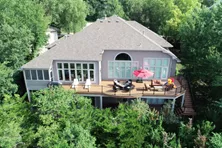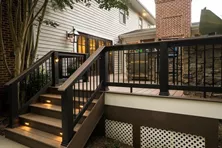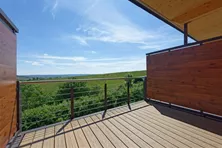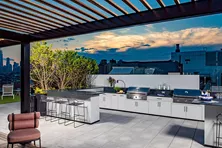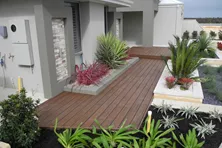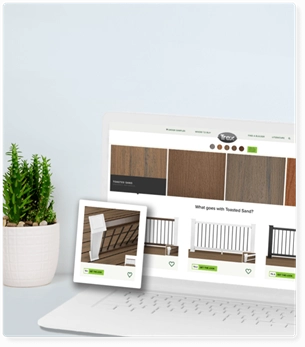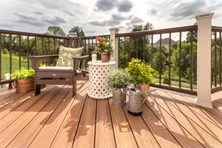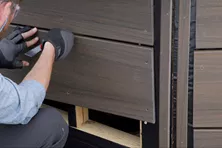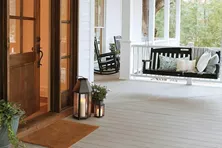Everything You Should Know Before You Buy Cable Deck Railing

The archetypal wooden railing is giving way to the minimalist, industrial look of cable rail systems. With its sleek lines and near-invisibility, you’ll create an ultra-modern aesthetic without impeding your view like wooden railings do. The increased interest in commercial and industrial design within the residential setting means homeowners can now integrate these once-exclusive products into their decking design.
However, with the vast number of manufacturers producing cable decking systems of various designs, it can be difficult to distinguish one product from the next. So allow us to guide you through everything you should know before you buy cable deck railing.
What is Cable Deck Railing?

Cable decking railings use tensioned stainless steel cable in place of traditional railing components such as balusters and pickets. By removing bulkier materials such as wood, composite, and aluminum, your deck appears more streamlined thanks to the unobstructed view.
Due to the wide range of cable deck railings, limitless tailored designs are available. For the most part, though, cable railings fall into four prominent categories:
- Post-to-post cable decking railing systems use stainless steel cables at vertically spaced intervals connected between each consecutive post. The cables are held in place and tensioned using various available fixings/mounts.

- Through-post cable decking railing systems use stainless steel cables that are only connected to end posts. All posts between the end posts have drilled holes to allow the cables to pass through.
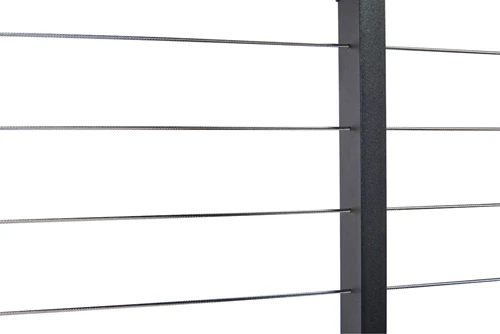
- Vertical cable railing systems utilize the handrail and the bottom rail to attach vertical cables instead of attaching them to posts. The cables are held in place and tensioned with stainless fixings/mounts.
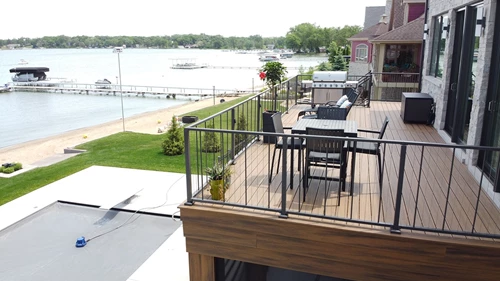
- Panel cable railing systems use a frame system incorporating posts and rails. These modular panels are then fixed between the main posts of the deck railings. This system requires additional structure and, therefore, has a less minimalist appearance.
Is Cable Deck Railing Worth It?
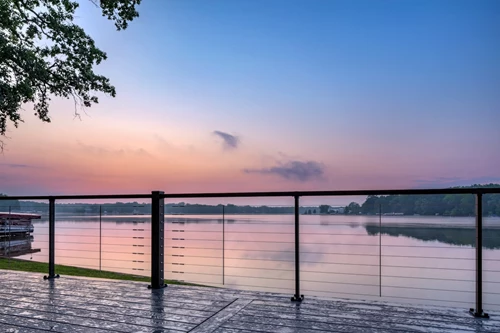
Railings are an integral element of your deck design, along with the decking material, deck shape, and material color. With a wire deck railing system, you can achieve a contemporary aesthetic that’s in perfect harmony with the modern structuring of your deck. Opting to use traditional railing systems will not only obscure your clear view of your surrounding environment but also detract from the contoured appearance of your deck. If you aim to complement your avant-garde decking, cable railings are an excellent choice.
What are the Benefits of Cable Railing?
Wire railing systems have distinct advantages, making them a worthwhile investment. Here’s a closer look at the benefits of cable railing systems.
Simple Installation
Whether you’re a contractor or into DIY, a cable railing system is easy to install. As long as you have a plan in hand, the right tools, and materials from a reputable manufacturer, you’ll have your railing system up in no time.
Increased Durability
As mentioned, cable railing systems use stainless steel, which is highly resistant to corrosion and rust. This means that steel cable railing systems avoid issues such as timber rot and pest infestation, resulting in a much longer lifespan.
Unobstructed Views
Cable railings are practically see-through when incorporated within a railing system. They are a fantastic method of pulling nature closer and allowing you to enjoy breathtaking panoramas.
Complementing Design
Traditional railing systems can look out of place when installed in a state-of-the-art environment. Wire railing systems complement other modern materials and structures, creating an uninterrupted visual flow.
Fits Any Space
No matter the design of your deck, cable railings may be adapted to cover every corner and crevice, thanks to the extensive range of materials, posts, and tension kits. It’s easy to configure the railing system in a way that still delivers that contemporary look you’re after.
Return On Investment
Wire railings are a great way to enhance a private residence. Adding high-quality cable railing to a home not only makes for a beautiful deck but also adds value to your property.
What are the Negatives of Cable Railing?
Cost of Installation
The cost of materials and installation of wire railings typically exceeds that of alternate products such as wood and composite railing systems. However, with the reduced ongoing maintenance cost, wire railings are not as expensive in the long term as one might first think.
Loss of Cable Tension
The cables in a wire railing system tend to lose tension over time. As a result, they need to be re-tensioned to ensure they provide sufficient fall protection. Re-tensioning is usually a simple process. However, there is an interim period when the cables may not provide adequate fall protection to the deck user. Trex offers a premium-grade stainless steel cable that’s uniquely spring-loaded for optimal tension management.
Permits & HOA Approval
When installing a handrail system, including a wire system, a permit from the local municipalities usually needs to be acquired. Unfortunately, not all municipalities allow the use of wire railing.
In addition to municipality approval, Homeowners Associations are required to approve handrails. If your property falls within the jurisdiction of an HOA, they normally have the final say on what you can and cannot install, including cable handrail systems.
How Much Does Cable Railing Cost?
The cost of cable railing can greatly vary depending on a range of contributing factors. Depending on your specific requirements, you can expect to pay anywhere between $150 - $300 or more per linear foot. Here are a few factors that can affect the cost of cable railings.
Railing Specification
Due to the vast range of cable railing design options, various products are available. This can include requiring additional hardware for post-to-post designs or metal posts over timber posts.
Site Requirements
Wire railing systems can be installed at various stages of a new project or as a retrofit install. As a result, site conditions will vary from one project to the next. For example, you may be able to use existing posts, or you may need new posts. These simple differences will affect how much you can expect to pay for cable railing systems.
Material Availability
When ordering materials, you will likely see a variation in cost per foot due to factors such as how much material you need, where the material is being shipped from, and even the cost of material based on fluctuating raw materials costs.
Manufacturer
Manufacturers of cable railing systems can play a huge factor in the cost of a steel railing installation. Large, reputable manufacturers provide products of a high standard, which, expectedly, come at a higher cost to the end-users. On the other hand, unbranded products, while more affordable, will inevitably corrode quickly due to their low-grade materials. So any savings made at the point of installation can quickly be spent on extensive maintenance and railing replacements. It's also worth noting that some low-grade products do not meet industry standards and will not pass permit inspections.
Contractor Vs. DIY
The labor element of an outdoor cable railing system makes up a large portion of the installation cost. These costs can be avoided if you choose to take a DIY approach. However, doing the installation yourself doesn't mean you'll save the entire cost of the contractor's labor. Items such as contractor discounts, tool hire, and experience will all have to be added back into the costs.
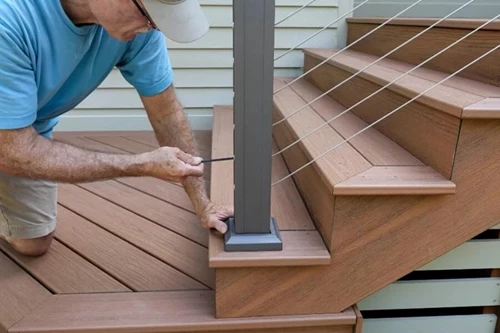
Is Cable Deck Railing Cheaper than Wood?
As a general rule, steel cable railings are more expensive than traditional wood railing systems. However, the margin between the two systems will vary depending on the specifications. For example, cedar is a more expensive wood than treated pine, whereas brushed stainless steel is more costly than aluminum. So, when comparing the two systems, it's essential to understand the materials and what is causing the cost difference. Additionally, when considering the long-term costs of wood deck railings vs. cable deck railing, it's important to factor in the ongoing annual maintenance costs of timber.
Can You Do Cable Railing with Wood Posts?</4>
Wooden posts can support outdoor cable railings. This is a common construction method seen in numerous installations. However, any wood element incorporated within a railing system will be susceptible to rot and ongoing maintenance issues. In addition, timber posts do not have the same structural strength and durability as metal or composite posts.
Are Cable Railings Cheaper than Glass?
Entry-level cable railing and glass deck railing systems start at around $150 per linear foot. Again, this will vary due to specifications and brands. Once you eliminate items such as support posts and capping handrails from glass railing systems, the cost will increase and typically surpass that of cable railings.
With both systems, you can have an uninterrupted view and a modern feel. However, when installing glass deck railings, it's important to remember that they need regular cleaning and are not so easy to see through when it rains.
Are Cable Deck Railings Safe?
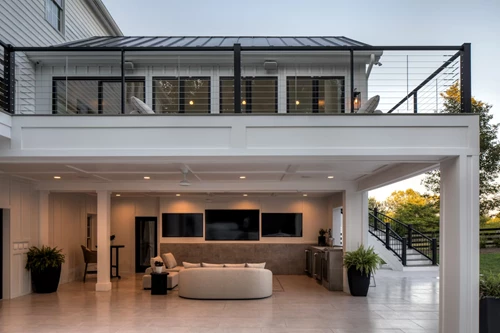
Code-compliant cable deck railings are safe if installed correctly and maintained. Avoiding inferior products and poor workmanship is crucial. Issues like under-tensioning, over-tensioning, inadequate support, neglect, and improper installation can compromise safety.
Wire railings must adhere to strict codes on specifications like spacing and height. If they meet these codes, are installed per manufacturer instructions, and are tensioned correctly, they are safe for kids. However, supervision is recommended near any railing.
Do You Need a Top Rail for Cable Railing?
The top rail is an essential element of a wire railing system. It is the part of the railing system that provides the lateral structural support between posts. The top rail prevents the posts from pulling together once tension is applied to the cables. The cable railing would collapse without the rail, so top rails are a code requirement.
Where Can You Put Cable Railing on a Deck?
Cable railings can be used on a deck for several different reasons, including fall prevention, assistance for stairs, and separating areas. Depending on the design of your deck, some of these elements may be a requirement under code. For example, decks over a certain height off the ground require a railing, and decks with stairs of certain specifications also need railings.
Can You Add Cable Railing to an Existing Deck?
If you already have a deck, you can add a cable railing system with some modifications. For example, this may include installing new posts, replacing or cutting decking boards, or removing an existing railing system. However, depending on the original construction of the decking, you may need to reinforce the subframe to ensure the railing system is adequately supported. These types of modifications are necessary to ensure the new railing system is safe and meets code requirements.
Can Cable Railing Go Around Corners?
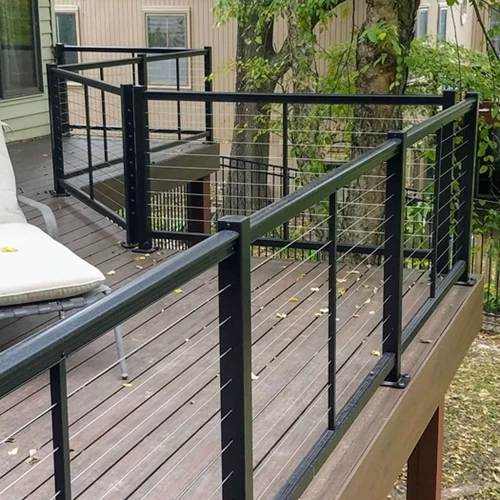
Steel cable railing can be installed at various angles, including around corners and following a deck's curve. As long as posts are positioned at the point where the railing's angle changes, the cables will be correctly supported. In addition to changing the angle of the cables within the wire railing on a flat surface, they can also change their height to accommodate stairs.
What to Look for When Buying Cable Deck Railing
When beginning your cable decking project, you should consider several factors to ensure that you install strong, durable, safe, and, of course, beautiful deck railing.
- Steel cable is available in a range of grades and quality. Make sure to use a high-quality exterior-grade material suitable for railing systems.
- Fixings used to secure steel cables to posts and structures are available in various designs and finishes. Not only will you need to select fixings to suit your design, but also ones designed for deck railings.
- Posts and rails are available in different materials, from wood and metal to composite products such as Trex Deck Railings. Once you have an idea of what you are looking for, you'll be able to narrow down the options to select the right material.
- Making sure that materials are code-compliant before selecting and purchasing will ensure you avoid inspection and safety issues.
Checking that licensed installers are available ahead of time will ensure that your project is completed without delay and that your deck railing is installed correctly.
Introducing Trex Signature® X-Series™ Cable Railing

The Trex Signature® X-Series™ cable railing offers a durable and stylish solution for outdoor spaces, combining strength with aesthetic appeal. Crafted with innovative design and modularity, this railing system features powder-coated aluminum posts and premium stainless steel cables for longevity and tension management. The installation process involves securing anchor posts, positioning pass-through posts every six feet, assembling stainless steel cables through ball ends and push-to-connect fittings, and installing a cable brace for stability.
Customization options include various lengths and heights to suit different applications, comprehensive kits containing essential components, and anchor posts with specific dimensions for seamless installation. By choosing the Trex Signature® X-Series™ cable railing, homeowners can enhance their outdoor spaces with lasting beauty and enduring style, backed by strong warranties and ease of installation for a customized outdoor experience.
Ready to get started with your DIY cable deck railing project? Find a contractor or shop for decking materials near you.
See Other Ideas About Deck Railing
Check out the following links to get you started on your deck railing project and other decking projects.
Glass Deck Railing Ideas and DIY Installation Tips
All glass panels used for deck railings must be safety-tempered and shatter-resistant. Learn how to install glass railing panels and get ideas for your deck.
Deck Railing Codes
Learn about the building codes that regulate guardrails. How high do rails need to be? What are the rail infill requirements?
How to Build a Deck Privacy Screen
In some deck design situations, you may feel that it is important to block certain views to increase privacy. This can usually be achieved by building a privacy wall or fence.
Deck Skirting
Skirting can be an attractive feature that can be added to any low-level deck.
7 Outdoor Storage Ideas & Tips
Free up valuable space in your home with outdoor storage options. Find unique ideas for outdoor storage as well as some tips for organizing at Decks.com.
Best Plants & Flowers to Brighten Up Your Deck
If you’re looking to brighten up your outdoor space this summer, try adding one of these plants or flowers to your deck or patio.
More Helpful Resources
Explore Articles by Topic

Footings
Information related to installing frost footings for decks

Framing
Learn structural framing methods

Decking
Learn about wood and composite decking materials

Stairs
An in-depth look at the complex issue of how to build stairs

Railings
How to install guardrails and handrails to meet IRC code

Features
An overview on water drainage, benches, planters and lights

Design
The basics of deck design

Planning
Learn about permits and working with contractors

Porches & Patios
Build a covered deck to enjoy all seasons

Ledger
Proper attachment techniques

Care
Maintain your deck to maintain your investment

Materials
An overview on water drainage, benches, planters and lights
Deck Railing Safety for the Whole Family
Make your deck safe for everyone who uses it. Follow this expert advice on deck railing installation, maintenance and safety features to prevent falls and hazards
How to Choose the Right Deck Railing
As one of the most visible elements of a deck, railings add support, safety and style. Get tips for choosing the right deck railing at Decks.com.
How to Install Metal Deck Railings
Metal deck railings can add a sophisticated and modern look to your deck. Learn how to install metal and aluminum deck railings
5 Best Ways on How to Hide Trash Cans Outside
Outdoor trash cans can be an unwanted eyesore. Discover how you can easily cover them up and add an extra touch of beauty to your yard.
Deck Skirting Ideas
Deck skirting offers more than aesthetics. From added storage to critter deterrence and concealing structures, explore our top ideas for your backyard's transformation.
The 9 Best Porch Swings for 2025
Porch swings are a great way to add charm and comfort to any home. Get our recommendations for how to choose the best porch swing.
Explore Articles by Topic

Footings
Information related to installing frost footings for decks

Framing
Learn structural framing methods

Decking
Learn about wood and composite decking materials

Stairs
An in-depth look at the complex issue of how to build stairs

Railings
How to install guardrails and handrails to meet IRC code

Features
An overview on water drainage, benches, planters and lights

Design
The basics of deck design

Planning
Learn about permits and working with contractors

Porches & Patios
Build a covered deck to enjoy all seasons

Ledger
Proper attachment techniques

Care
Maintain your deck to maintain your investment

Materials
An overview on water drainage, benches, planters and lights




